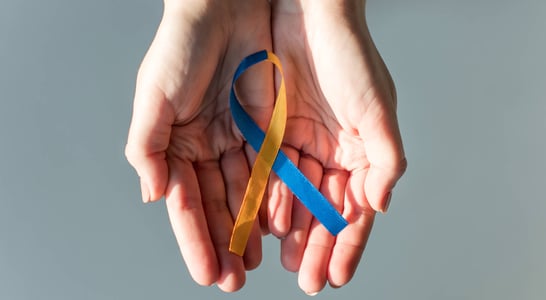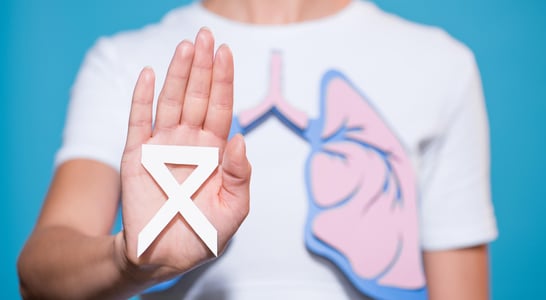
World AIDS Day
Don a red ribbon to raise awareness of this prevalent condition, counter misinformation and stigma and donate to education and research efforts.
When the AIDS epidemic broke, because I happened to be a science nerd and knew a lot about viruses and a lot about that virus at the time, I felt a moral obligation to go out and try to stem the fear and get out and explain to people what the disease was and how it worked.
Morgan Fairchild
Acquired Immune Deficiency Syndrome, when discovered in the 1980s, seemed to reach out into the world and change the way humans previously thought about almost everything, from how they got their vaccinations or blood transfusions to the way they chose their sexual practices.
The revelation of this disease and the virus behind it (Human Immunodeficiency Virus) was met with a campaign of fear and superstition that had the power to harm both those who had it, and even further out into the families and friends of those who surrounded them.
While HIV and AIDS are certainly still out in the world today, the horror stories that were told of how it works and how it was transmitted have largely been mitigated.
World AIDS Day works to ensure that those who suffer from AIDS can live in a safer, more understanding world and help further research to eliminate this life-altering virus that can turn into a deadly disease.
History of World AIDS Day
World AIDS Day was first held in 1988, just four years after the discovery of the virus and its official classification.
Since the discovery of the virus and its subsequent disease, more than 35 million people have died from AIDS, putting it far ahead of many of the other most devastating diseases in the history of humans.
HIV works in the body by weakening its natural immune system through the destruction of cells that would normally protect the body by fighting off infections.
From the onset of HIV/AIDS, the work of men and women all over the world has led to a greater understanding of the disease (a person can’t contract it by sharing a can of coke or a toilet seat, for instance), but that has only served to slow the tide but has not stopped it.
The spread of the disease is still prevalent today, with more than 1.5 million people each year diagnosed with HIV throughout the globe. And even with the campaign to help with awareness, many people are still out there who don’t know or understand the truth or facts about it.
World AIDS Day Timeline
1981
AIDS is first officially reported
Five gay men in San Francisco, USA are reported in a medical journal as having unusual infections and compromised immune systems that ultimately lead to all of their deaths.[1]
1988
World Health Organization (WHO) declares first World AIDS Day
After launching The Global Program on AIDS in order to raise awareness about the issue the previous year, The WHO instills December 1st as World AIDS Day.[4]
1996
World AIDS Day changes hands
The scope of the project is expanded when the day’s organization is passed on to the Joint United Nations Program on HIV/AIDS (UNAIDS).[5]
2018
South Africa has largest HIV epidemic
With more than 7.7 million cases of the virus and responsible for at least 71,000 deaths, South Africa is declared the place with the largest HIV epidemic in the world. Women are disproportionately affected and the need for awareness is great.[6]
How to Celebrate World AIDS Day
Observing this day is more than just personal. AIDS is an issue that affects the entire planet and needs to be treated with the proper attention.
Get involved by participating in some of these ways, or come up with some other creative and proactive ideas of your own:
Get Educated About AIDS and HIV
Start off the observance of this day by educating yourself and your family about AIDS by finding resources on websites such as worldaidsday.org.
Since there is a lot of misinformation out there in the world, do be sure that the places where the information on AIDS/HIV comes from are respected, trusted, viable resources that are offering truthful and factual information.
For instance, here are some important pieces of basic information to get started:
- There still is no cure for HIV. While full-blown AIDS can now be avoided by some people who have HIV, and there are treatments to help people live a more normal and full life, HIV is still no joke and should be taken as seriously as any other potentially fatal disease.
- HIV/AIDS is spreadable, even when being treated. One of the most important ways to stop the virus is to avoid sharing it. Those who have it should be well-educated by their doctors to understand exactly what precautions they need to take to keep from spreading it to other people, based on their viral load.
- Getting AIDS does not have to mean that your life is over. While the best way to stay healthy is to avoid HIV and AIDS altogether, many advances have been made in treatment to help people with the virus to live healthy, normal lives and even to have healthy children.
- Treatment for HIV/AIDS is no longer very complicated. While an HIV/AIDS diagnosis used to mean a significant interruption to a person’s lifestyle, today those with the disease usually have to take between one and four pills per day.
Find Ways to Help with AIDS and HIV
Once a beginning of understanding about the facts has come about, a great way to move forward would be to start researching what ways that it is possible to help.
Whether it’s a small donation to help fund education and research, or volunteering some time to help with their campaigns and causes, every little bit helps. There is not much that can be done that is more worthwhile than helping to end the epidemic that is HIV/AIDS!
Wear a Red Ribbon for World AIDS Day
One simple way to show support for this effort is by choosing to wear a red ribbon on World AIDS Day to help spread awareness of the disease.
Go one step further and hand out red ribbons to friends, neighbors, co-workers and family members to help them spread the word as well.
While sharing ribbons, be sure to share facts too! It’s important that everyone understand the dangers of HIV/AIDS, and just as important that they understand how it’s contracted. Not just as a way to avoid contracting it, but to reduce the fear that surrounds this horrible condition.
World AIDS Day FAQs
How did the red ribbon become the symbol for AIDS awareness?
In 1991, a group of artists in New York formed the Visual AIDS Artists Caucus.
They created the red ribbon as a symbol of solidarity with those living with HIV/AIDS.
The color red was chosen for its connection to blood and the idea of passion. The ribbon’s simple design allowed it to be easily replicated and worn, spreading awareness globally.
What is the significance of the “Day Without Art” on December 1st?
“Day Without Art” began on December 1, 1989, as a national day of action and mourning in response to the AIDS crisis.
Art institutions covered artworks or closed their doors to symbolize the impact of AIDS on the arts community.
Over time, it evolved into “Day With(out) Art,” featuring proactive programming to raise awareness and honor those lost.
Which country hosts the Life Ball, one of the world’s largest AIDS charity events?
Austria hosts the Life Ball in Vienna. Established in 1992, it’s one of the world’s biggest AIDS charity events, combining flamboyant fashion shows with performances to raise funds for HIV/AIDS projects.
How did Elizabeth Taylor’s activism influence AIDS awareness?
After her friend Rock Hudson’s death from AIDS-related complications in 1985, Elizabeth Taylor became a fervent activist.
She co-founded the American Foundation for AIDS Research (amfAR) and later established the Elizabeth Taylor AIDS Foundation, significantly advancing research and awareness.
What unique event did the AIDS Healthcare Foundation organize in 2022?
In 2022, the AIDS Healthcare Foundation hosted a World AIDS Day concert at the Kennedy Center in Washington, D.C.
The event featured performances by Patti LaBelle and Gladys Knight, aiming to raise awareness and funds for HIV/AIDS initiatives.
How did the “Two x Two” fundraiser contribute to AIDS research?
The “Two x Two” fundraiser, held annually in Dallas, Texas, combined art auctions with gala events.
Over 25 years, it raised substantial funds for amfAR and the Dallas Museum of Art, significantly supporting AIDS research and awareness.
What is the New Orleans AIDS Monument, and when was it unveiled?
The New Orleans AIDS Monument, titled “The Guardian Wall,” was unveiled in 2008. Located in Washington Square Park, it features bronze and glass elements honoring those affected by HIV/AIDS.
How did the “Day With(out) Art” initiative adapt during the COVID-19 pandemic?
In 2020, due to the pandemic, Visual AIDS organized online programming for “Day With(out) Art.”
They commissioned diverse video works and hosted virtual talks, making the event accessible globally despite restrictions.
What role did John Chittick play in global AIDS awareness among teens?
John Chittick launched the first interactive global webcast for teens on World AIDS Day in 2006. This initiative connected young people from 80 countries, promoting HIV/AIDS awareness and education.
How did the Solomon R. Guggenheim Museum participate in “Day Without Art”?
In 1989, the Guggenheim Museum in New York draped a large black sash over its building.
This act symbolized mourning and raised awareness about the impact of AIDS on the arts community.
Also on ...
View all holidaysNational Cookie Cutter Day
Transform your cookies with fun shapes and designs. Cookie cutters are a must-have tool for any baking enthusiast.
Walt Disney Day
Binge some favorite childhood movies, plan a trip to “the most magical place on earth” or enjoy some Disney-themed activities like baking and crafting.
National Christmas Lights Day
Creating a luminous wonderland that brightens the darkest season, celebrating with glimmering decorations that adorn the night.
Wear a Dress Day
From flowing sundresses to elegant evening gowns, there's a dress for every occasion. So twirl, dance, and let your inner diva shine in a dress that makes you feel like a million bucks!
We think you may also like...
Down Syndrome Awareness Month
Donate your money or time to an organization or charity that supports those with the common disorder known as Down Syndrome, which effects 1 in 800 children.
National Cancer Survivors Day
Join an organization or event to celebrate those who have fought or are fighting their battle against cancer, and raise awareness of the struggles they face.
World Lung Cancer Day
Help raise awareness and support research into lung cancer, so we can prevent, treat, and eventually cure one of the most common and deadly cancers.








